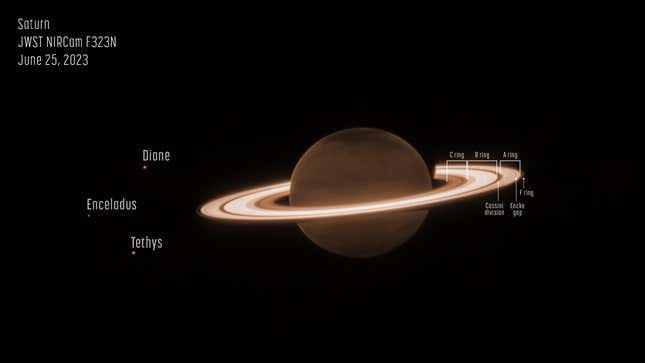Isaac Schultz
The Webb Space Telescope has taken an image of the ringed planet Saturn, completing its photo album of our solar system’s gas giants.
Webb Telescope Images the Pillars of Creation
Off
English
Webb is a $10 billion space observatory launched in December 2021. The telescope consists of two imagers: the Near-Infrared Camera (NIRCam) and the Mid-Infrared Instrument (MIRI). Webb has been producing scientific images since July 2022.
Though one of Webb’s primary focuses is the earliest light it can see, which dates back to several hundred million years after the Big Bang, it also is providing insights on our stellar neighborhood. The new image of Saturn complete’s the telescope’s tour of our solar system’s gas giants, or the nearby worlds mostly composed of helium and hydrogen.
Jupiter was the first planet to be imaged by Webb, in August 2022. The Webb team produced an image of Neptune—including its rings and moons—in September and followed that image up with a shot of the rings rimming Uranus, the seventh planet from the Sun.
The image of Saturn was taken on June 25, using Webb’s NIRCam. Saturn appears quite dark because the planet’s methane absorbs much of the sunlight that hits the planet’s atmosphere. The planet’s rings, mostly composed of ice and rock, remain luminous.
The Cassini division, a gap between the planet’s A ring and B ring caused by the gravitational pull of Saturn’s moon Mimas, is also visible in the image.
And speaking of moons: on the left side of the image are the Saturnian satellites Dione, Tethys, and Enceladus. Webb imaged Enceladus in May, and found a 6,000-mile-long (9,660 km) water plume spewing from the icy moon. Enceladus is of significant scientific interest because it has a subsurface ocean, and water is a prerequisite for life as we know it.
Last month, data from the Cassini spacecraft—whose mission ended in 2017, when it plummeted into Saturn’s atmosphere—revealed the presence of phosphorus in Enceladus’ water, another boost to the prospect of life hiding away beneath the moon’s icy crust.
But until a dedicated mission to Enceladus gets off the ground, we may have to settle for the insights of Webb’s unflinching gaze.
More: Then and Now: Our Earliest Close-Ups of the Planets Compared to Today’s Best Shots
exoplanets.nasa.gov:https://gizmodo.com/webb gizmodo.neptune-rings gizmodo.uranus gizmodo.com/webb-telescope-spots-large-plume gizmodo.com/saturn-moon-enceladus-phosphorus caps.gsfc.nasa.gov/simson/kingswood/rings/

I've seen so many pictures of Saturn over the years, and I've heard the rings can be luminous, but never has the quality been good enough to truly demonstrate how luminous.
Simply amazing.